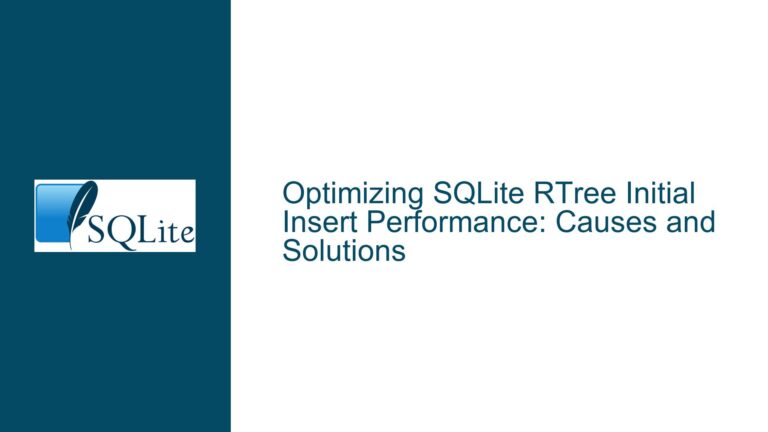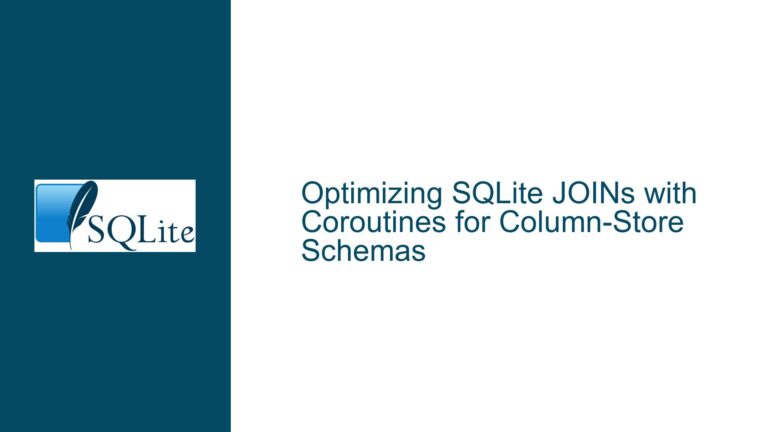Optimizing SQLite Queries with CTEs and JOINs for Performance
Understanding the Performance Discrepancy Between CTE and Literal Queries
The core issue revolves around a significant performance discrepancy between two SQLite queries that achieve the same result but are structured differently. The first query uses a Common Table Expression (CTE) with a WITH clause and LEFT JOIN operations, while the second query directly uses a literal value for filtering and employs INNER JOIN operations. The CTE-based query takes over 50 seconds to execute, whereas the literal-based query completes in just 0.015 seconds. This stark difference in performance raises questions about the efficiency of CTEs and JOIN operations in SQLite, particularly when dealing with large datasets or complex filtering conditions.
The CTE-based query is designed to reuse a single value (PR0000014888) across multiple JOIN operations, which is a common practice to avoid redundancy. However, the execution plan generated by SQLite for this query appears to be suboptimal, leading to excessive computation time. On the other hand, the literal-based query bypasses the overhead of the CTE and directly filters the data using a hardcoded value, resulting in a much faster execution. This discrepancy suggests that the way SQLite handles CTEs and JOINs in this context may not be as efficient as expected.
To fully understand the issue, we need to examine the structure of both queries, the underlying data, and the execution plans generated by SQLite. The CTE-based query involves multiple nested subqueries and JOINs, which can lead to complex execution plans that are difficult for the query optimizer to handle efficiently. In contrast, the literal-based query simplifies the filtering process by directly specifying the value, allowing the optimizer to generate a more straightforward and efficient execution plan.
Analyzing the Impact of JOIN Types and CTE Usage on Query Performance
The performance discrepancy between the two queries can be attributed to several factors, including the types of JOINs used, the placement of the CTE, and the complexity of the filtering conditions. In the CTE-based query, the LEFT JOIN operations are used to combine the Project_List and ABT_Budget tables with the PID CTE. However, the WHERE clause in the query imposes conditions that effectively nullify the benefits of using LEFT JOIN, as it requires matching rows from all tables. This creates a situation where the query optimizer may struggle to generate an efficient execution plan, leading to longer execution times.
The use of LEFT JOIN in this context is unnecessary because the WHERE clause ensures that only rows with matching values in all tables are included in the result set. This means that the query could be rewritten using INNER JOIN operations, which are generally more efficient for such scenarios. Additionally, the placement of the PID CTE outside the JOIN operations further complicates the execution plan, as it forces the optimizer to evaluate the CTE multiple times during the query execution.
In contrast, the literal-based query simplifies the JOIN operations by directly specifying the value PR0000014888 in the WHERE clause. This eliminates the need for the CTE and reduces the complexity of the execution plan. The use of INNER JOIN in this query ensures that only matching rows are included in the result set, which further improves performance. The query optimizer can generate a more efficient execution plan for this simplified query, resulting in significantly faster execution times.
Another factor contributing to the performance discrepancy is the way SQLite handles CTEs. While CTEs are a powerful tool for organizing complex queries, they can introduce overhead, especially when used in conjunction with JOINs and nested subqueries. In this case, the CTE-based query requires the optimizer to evaluate the CTE multiple times, which can lead to inefficiencies. The literal-based query avoids this overhead by directly specifying the value, allowing the optimizer to focus on the core filtering and JOIN operations.
Strategies for Optimizing CTE and JOIN Performance in SQLite
To address the performance issues in the CTE-based query, several optimization strategies can be employed. The first step is to replace the LEFT JOIN operations with INNER JOIN operations, as the WHERE clause already ensures that only matching rows are included in the result set. This change simplifies the execution plan and allows the optimizer to generate a more efficient query.
The next step is to reconsider the placement of the PID CTE. Instead of placing it outside the JOIN operations, the CTE can be integrated into the JOIN conditions. This ensures that the CTE is evaluated only once, reducing the overhead associated with multiple evaluations. Additionally, the CTE can be replaced with a temporary table or a subquery, depending on the specific requirements of the query.
Another optimization strategy is to simplify the filtering conditions in the query. The current query uses nested subqueries to determine the maximum InsertDate for each table, which can be computationally expensive. These subqueries can be replaced with simpler filtering conditions or precomputed values, reducing the complexity of the execution plan.
Finally, it is important to analyze the execution plan generated by SQLite for the CTE-based query. This can be done using the EXPLAIN QUERY PLAN statement, which provides insights into how the query is being executed. By examining the execution plan, it is possible to identify bottlenecks and inefficiencies, which can then be addressed through further optimization.
In conclusion, the performance discrepancy between the CTE-based and literal-based queries can be attributed to the use of LEFT JOIN operations, the placement of the CTE, and the complexity of the filtering conditions. By replacing LEFT JOIN with INNER JOIN, reconsidering the placement of the CTE, simplifying the filtering conditions, and analyzing the execution plan, it is possible to significantly improve the performance of the CTE-based query. These optimization strategies not only address the immediate performance issue but also provide a framework for optimizing similar queries in the future.






